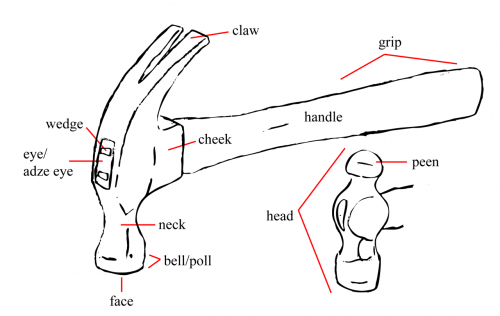
The Versatile Hammer: A Comprehensive Guide
Introduction
The hammer is one of the oldest and most widely used tools across various industries, from carpentry and construction to metalworking and DIY projects. While simple in design, it serves many purposes and comes in different forms tailored to specific tasks.
- Types of Hammers
There are numerous types of hammers, each suited for a different job:
• Claw Hammer: The most common type, ideal for driving nails into wood and removing them with its claw. Essential in carpentry and household tasks.
• Ball Peen Hammer: Typically used in metalworking, the rounded end is perfect for shaping and striking metal, while the flat side is used for general pounding.
• Sledgehammer: This heavy-duty hammer is used for breaking concrete, masonry, and demolition work. Its size and weight deliver powerful strikes.
• Rubber Mallet: Unlike metal hammers, rubber mallets provide a softer strike, preventing damage to surfaces. Commonly used in woodworking and assembling furniture.
• Tack Hammer: A lightweight hammer with a small head, used for driving in small nails, tacks, and brads.
- Hammer Materials
The effectiveness of a hammer is partly due to its material. Common materials include:
• Steel Head: Offers strength and durability for heavy-duty tasks.
• Fiberglass Handle: Lightweight and reduces vibrations, making it comfortable for long use.
• Wooden Handle: Classic option, often found in claw hammers, providing a firm yet comfortable grip.
- Proper Hammering Technique
Using a hammer correctly can prevent injury and improve efficiency:
• Grip: Hold the hammer at the end of the handle for better leverage.
• Strike: Use a controlled, smooth motion, letting the weight of the hammer do the work. Avoid excessive force to prevent missing or damaging the material.
• Eye Protection: Always wear safety glasses to protect from flying debris when striking hard materials.
Applications of Hammers
• Carpentry: For driving nails and framing.
• Metalworking: Shaping metal in forging and fabrication.
• Demolition: Breaking down walls, concrete, and other structures.
• Household Repairs: Fixing furniture, hanging pictures, or assembling items.Hammer Maintenance and Safety
Proper care extends the life of your hammer:
• Inspect Before Use: Check for cracks in the handle and head. A loose head can be dangerous.
• Store Properly: Keep hammers in a dry place to prevent rust and handle wear.
• Use the Right Hammer: Always select the correct hammer type for the job to avoid damaging materials or injuring yourself.
Conclusion
Hammers are simple but powerful tools with a wide range of applications. Whether you’re a professional carpenter or a weekend DIY enthusiast, choosing the right hammer and using it properly can make your tasks easier and safer. From driving nails to breaking concrete, hammers remain an essential tool in every toolbox.
Do you have a favorite hammer type or hammering technique? Let me know in the comments below! 👇
The Versatile Hammer: A Comprehensive Guide
Introduction
The hammer is one of the oldest and most widely used tools across various industries, from carpentry and construction to metalworking and DIY projects. While simple in design, it serves many purposes and comes in different forms tailored to specific tasks.
- Types of Hammers
There are numerous types of hammers, each suited for a different job:
• Claw Hammer: The most common type, ideal for driving nails into wood and removing them with its claw. Essential in carpentry and household tasks.
• Ball Peen Hammer: Typically used in metalworking, the rounded end is perfect for shaping and striking metal, while the flat side is used for general pounding.
• Sledgehammer: This heavy-duty hammer is used for breaking concrete, masonry, and demolition work. Its size and weight deliver powerful strikes.
• Rubber Mallet: Unlike metal hammers, rubber mallets provide a softer strike, preventing damage to surfaces. Commonly used in woodworking and assembling furniture.
• Tack Hammer: A lightweight hammer with a small head, used for driving in small nails, tacks, and brads.
- Hammer Materials
The effectiveness of a hammer is partly due to its material. Common materials include:
• Steel Head: Offers strength and durability for heavy-duty tasks.
• Fiberglass Handle: Lightweight and reduces vibrations, making it comfortable for long use.
• Wooden Handle: Classic option, often found in claw hammers, providing a firm yet comfortable grip.
- Proper Hammering Technique
Using a hammer correctly can prevent injury and improve efficiency:
• Grip: Hold the hammer at the end of the handle for better leverage.
• Strike: Use a controlled, smooth motion, letting the weight of the hammer do the work. Avoid excessive force to prevent missing or damaging the material.
• Eye Protection: Always wear safety glasses to protect from flying debris when striking hard materials.
Applications of Hammers
• Carpentry: For driving nails and framing.
• Metalworking: Shaping metal in forging and fabrication.
• Demolition: Breaking down walls, concrete, and other structures.
• Household Repairs: Fixing furniture, hanging pictures, or assembling items.Hammer Maintenance and Safety
Proper care extends the life of your hammer:
• Inspect Before Use: Check for cracks in the handle and head. A loose head can be dangerous.
• Store Properly: Keep hammers in a dry place to prevent rust and handle wear.
• Use the Right Hammer: Always select the correct hammer type for the job to avoid damaging materials or injuring yourself.
Conclusion
Hammers are simple but powerful tools with a wide range of applications. Whether you’re a professional carpenter or a weekend DIY enthusiast, choosing the right hammer and using it properly can make your tasks easier and safer. From driving nails to breaking concrete, hammers remain an essential tool in every toolbox.
Do you have a favorite hammer type or hammering technique? Let me know in the comments below! 👇